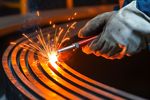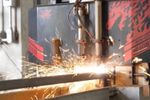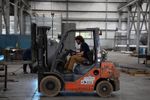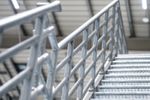Do you know if your metal fabrication is OSHA compliant? If your industrial ladder, platform, or skid isn’t constructed up to code, you could face steep OSHA fines or worse yet, a worker injury. But if you partner with an experienced, OSHA-savvy metal fabricator, they can apply your industry-specific regulatory requirements to protect against design flaws that can lead to costly liability.
If a fabricator applies safety best practices at their facility to protect their workforce, it’s a good indication they’re qualified to walk the OSHA talk when it comes to your custom project. Ask your potential partner if they follow these OSHA guidelines to safeguard their employees. If they can’t answer to your satisfaction, it’s time to look elsewhere.
1: Hearing Conservation Standard for OSHA-Compliant Fabrication
OSHA requires hearing protection at 85 decibels for an eight hour work shift and recommends no more than 15 minutes of exposure to 110 decibels or more. To put these noise levels into context, a Boeing 737 flying a mile away is approximately 90 decibels. A jet takeoff at 25 meters away could easily cause eardrums to rupture at 150 decibels, hence the obvious hearing protection needed for airport personnel.
Workers at a fabrication facility face less extreme decibel threats, but cutting, grinding, and other power equipment-related tasks require careful monitoring of noise level standards.
Experienced fabricators mitigate these dangers by:
- Limiting the time each worker spends in a noisy environment
- Requiring PPE if extended noise exposure is required for a task
- Keeping machinery well maintained to reduce rattles and vibrations
- Alternating time spent on noisy jobs with quieter tasks
- Arranging noisy tools near the opening of the building to disperse the noise outside
Project managers should regularly ask employees if they ever experience ringing in their ears or if their ears feel “plugged” when they return to a quieter environment. Are employees having to raise their voices to communicate with coworkers at an arm’s length? If they answer yes, it’s time to do a noise assessment. An ounce of noise prevention can reap tons of bottom line savings from productive workers who are protected against decibel threats.
2: Hazard Communication Standard for OSHA-Compliant Fabrication
When working on welding and fitting tasks during metal fabrication assembly, it’s critical to ensure workers are aware of potential health risks, per OSHA’s Hazard Communication Standard. In a nutshell, the Communication Standard mandates that all employees have a right to know what type of hazards they may encounter in the workplace and how to protect themselves against them.
Some of the most potentially harmful welding hazards may include dust and/or fumes containing metals or gases that could expose employees to risks such as nose and throat irritation, dizziness, nausea, or even nervous system damage or cancers of the lung or larynx. Hexavalent Chromium is a particularly toxic metal component that can result from welding stainless steel.
Safety-savvy fabrication operations can reduce these risks by:
- Posting specific welding risks in writing at easily visible locations throughout the workplace
- Training employees to protect themselves by properly using PPE and conducting regular respirator checks
- Reducing exposure to toxic byproducts by teaching employees to regularly clean welding surfaces and coatings
- Realizing that working outdoors doesn’t guarantee safe ventilation and that employees need to stay upwind of fumes when working outside
- Keeping exhaust ventilation systems well maintained and cautioning employees to stay away from exhaust ports
- Reminding employees to never weld in a confined space with no ventilation
Additionally, ensuring worker safety during welding tasks goes beyond reducing air contaminant risks. It takes ongoing employee training to reinforce best practices such as never welding above your head, when to transition from a grinding safety shield and glasses to a splatter-resistant hood and protective sleeving, and ensuring welders are in proper physical condition before working in a hot, indoor area.
3: Equipment Safety Know-How for OSHA-Compliant Fabrication
From cutting and forming equipment to ladders and containers, every piece of equipment on the fabrication shop floor has a specific set of safety standards. OSHA is particularly diligent about enforcing machine guarding standards to prevent such severe machine injuries as burns, crushed fingers, or even amputations. Machine guarding was one of the most cited OSHA violations last year, along with eye and face protection, ladders and fall protection, and lockout/tagout.
Fabricators who understand the ROI of a safe, productive shop floor emphasize ongoing equipment training and safety best practices such as:
- Keeping work areas clear of scrap and clutter that could cause employees to step too close to machinery
- Ensuring every tool and piece of equipment is stored in its proper location
- Ongoing training such as:
- How to use correct machine guarding protection for such tasks as forming, cutting, sawing, sanding, or grinding
- How to wear PPE correctly, including hard hats, gloves, safety shoes, earplugs, full body suits, respirators, face shields, and goggles
- How to position yourself properly during welding, such as never welding above your head
- How to stand on a ladder properly (never stand on the top rung to perform a task)
- How to master the operation of such heavy equipment as cranes, forklifts, and rigging
4: Emergency Action Plan for OSHA-Compliant Fabrication
OSHA requires employers with more than ten employees to maintain a documented Emergency Action Plan (EAP) to ensure both managers and employees each have a clear course of action in the event of a tornado, flood, fire, or other man-made or natural disaster.
A fabrication shop EAP should include:
- Clear responsibilities for each employee for evacuation procedures and emergency escape routes
- Communication channels for workers to report fires and other emergencies
- Documented procedures for employees who must remain to operate critical plant operations before they evacuate (such as safely shutting down machinery before exiting the building)
- Specific guidelines for notifying all employees after an emergency evacuation has been completed
- Assigned rescue and medical duties if required, with proper training to ensure designated employees can perform these duties
- Prioritized list of managers and employees to contact for further explanation of EAP duties
For fabricators who make safety part of their overall safety culture, the Emergency Action Plan should play a key role in regular employee training and workplace best practices. A safety-first operation will also make OSHA compliance front and center in their quality control program.
5: Implementing a Safety-Savvy Quality Control Program for OSHA-Compliant Fabrication
Experienced metal fabricators make safety best practices an integral part of their documented quality control (QC) program. As part of the QC program at Southern Metal Fabricators, every employee undergoes regular safety education, including OSHA-mandated equipment training to ensure each welder, tacker, machine operator, and installer is fully qualified to perform the required duties per industry standards (ASME and AWS).
We don’t just claim to be OSHA compliant. We implement these standards into every industrial ladder, staircase, or platform to ensure the final product meets or exceeds the standards per each customer’s industry requirements.
These QC best practices include:
- Doing our OSHA due diligence through every part of the fabrication process, from design to installation
- Using our engineering expertise to calculate the tricky OSHA-compliant dimensions of each fabrication design
- Conducting regular quality control checks with the entire design team to make sure the final custom fabrication meets all safety standards
- Educating our employees on all machinery and equipment, as each piece of equipment has its own safety standards
- Ensuring any subcontractors working with our customers are doing their due diligence so the final product is installed according to OSHA guidelines
Our safety-first fabrication culture goes beyond shielding our employees from potential hazards. We’ve learned that meeting or exceeding OSHA standards is a key ingredient in the recipe for exceptional fabrication quality and ROI.
If you’re looking for a metal fabrication partner who can meet or exceed your quality and safety expectations, give Southern Metal Fabricators the chance to say, “Yes, we can do that!” by contacting us today.





